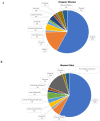Caregivers with Cancer Patients: Focus on Hispanics
- PMID: 36765585
- PMCID: PMC9913516
- DOI: 10.3390/cancers15030626
Caregivers with Cancer Patients: Focus on Hispanics
Abstract
Cancer is a public health concern and causes more than 8 million deaths annually. Cancer triggers include population growth, aging, and variations in the prevalence and distribution of the critical risk factors for cancer. Multiple hallmarks are involved in cancer, including cell proliferation, evading growth suppressors, activating invasion and metastasis, resisting cell death, enabling replicative immortality, reprogramming energy metabolism, and evading immune destruction. Both cancer and dementia are age-related and potentially lethal, impacting survival. With increasing aging populations, cancer and dementia cause a burden on patients, family members, the health care system, and informal/formal caregivers. In the current article, we highlight cancer prevalence with a focus on different ethnic groups, ages, and genders. Our article covers risk factors and genetic causes associated with cancer and types of cancers and comorbidities. We extensively cover the impact of cancer in Hispanics in comparison to that in other ethnic groups. We also discuss the status of caregivers with cancer patients and urgent needs from the state and federal support for caregivers.
Keywords: aging population; cancer; caregivers; cell proliferation; metastatic; resisting cell death.
Conflict of interest statement
The authors have no conflict of interest to report.
Figures







Similar articles
-
Obesity: a perfect storm for carcinogenesis.Cancer Metastasis Rev. 2022 Sep;41(3):491-515. doi: 10.1007/s10555-022-10046-2. Epub 2022 Aug 30. Cancer Metastasis Rev. 2022. PMID: 36038791 Free PMC article. Review.
-
Physical Exercise and the Hallmarks of Breast Cancer: A Narrative Review.Cancers (Basel). 2023 Jan 3;15(1):324. doi: 10.3390/cancers15010324. Cancers (Basel). 2023. PMID: 36612320 Free PMC article. Review.
-
Hallmarks of cancer: the next generation.Cell. 2011 Mar 4;144(5):646-74. doi: 10.1016/j.cell.2011.02.013. Cell. 2011. PMID: 21376230 Review.
-
The contribution of tumour-derived exosomes to the hallmarks of cancer.Crit Rev Clin Lab Sci. 2016;53(2):121-31. doi: 10.3109/10408363.2015.1092496. Epub 2015 Oct 19. Crit Rev Clin Lab Sci. 2016. PMID: 26479834 Review.
-
Cancer Hallmarks, Biomarkers and Breast Cancer Molecular Subtypes.J Cancer. 2016 Jun 23;7(10):1281-94. doi: 10.7150/jca.13141. eCollection 2016. J Cancer. 2016. PMID: 27390604 Free PMC article. Review.
Cited by
-
Challenges oncologists face when caring for hispanics living in puerto rico with colorectal cancer and multiple chronic conditions.BMC Cancer. 2025 May 20;25(1):898. doi: 10.1186/s12885-025-14271-0. BMC Cancer. 2025. PMID: 40394534 Free PMC article.
-
Support Provided by Caregivers for Community-Dwelling Diabetic Hispanic Adults with Intellectual Disabilities and Comorbid Conditions.Int J Mol Sci. 2023 Feb 14;24(4):3848. doi: 10.3390/ijms24043848. Int J Mol Sci. 2023. PMID: 36835260 Free PMC article. Review.
-
New insights in application of mesenchymal stem cells therapy in tumor microenvironment: pros and cons.Front Cell Dev Biol. 2023 Oct 2;11:1255697. doi: 10.3389/fcell.2023.1255697. eCollection 2023. Front Cell Dev Biol. 2023. PMID: 37849741 Free PMC article. Review.
-
Alzheimer's Disease and Alzheimer's Disease-Related Dementias in African Americans: Focus on Caregivers.Healthcare (Basel). 2023 Mar 16;11(6):868. doi: 10.3390/healthcare11060868. Healthcare (Basel). 2023. PMID: 36981525 Free PMC article. Review.
-
Examining posttraumatic growth among Turkish family caregivers of cancer patients.Sci Rep. 2024 Sep 3;14(1):20510. doi: 10.1038/s41598-024-71772-x. Sci Rep. 2024. PMID: 39227747 Free PMC article.
References
-
- Murphy S.L., Kochanek K.D., Xu J., Arias E. Mortality in the United States, 2020. NCHS Data Brief. 2021;427:1–8. - PubMed
-
- Abbas Z., Rehman S. An overview of cancer treatment modalities. Neoplasm. 2018;1:139–157.
Publication types
Grants and funding
LinkOut - more resources
Full Text Sources

